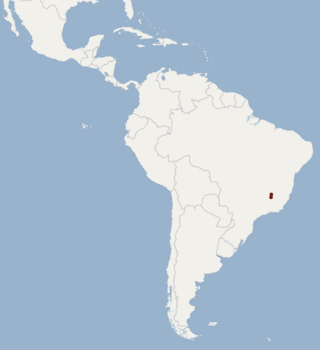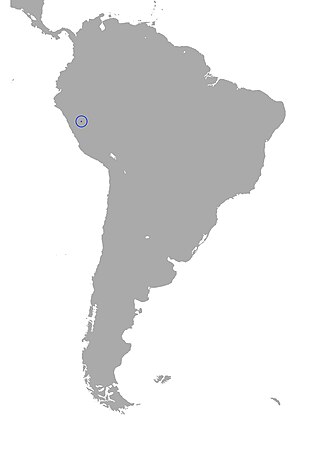
Caeciliidae is the family of common caecilians. They are found in Central and South America. Like other caecilians, they superficially resemble worms or snakes.

Bokermann's nectar bat is a bat species from South America. It is endemic to Brazil. It feeds on nectar, and is listed as an endangered species.

Amazophrynella bokermanni is a species of toad in the family Bufonidae. It is endemic to Brazil and only known from the region of its type locality, the Amazonas state. Its natural habitats are old-growth forests where it occurs in leaf-litter. The eggs are laid on aerial roots over temporary pools where the tadpoles then develop.

Caecilia antioquiaensis, the Antioquia caecilian, is a species of caecilian in the family Caeciliidae. It is endemic to Colombia and only known from its type locality in the Cordillera Central in Valdivia, Antioquia. It is a poorly known subterranean species, occurring in humid tropical forest.
Caecilia corpulenta is a species of caecilian in the family Caeciliidae. It is endemic to Colombia. Its natural habitats are subtropical or tropical moist montane forests, swamps, plantations, rural gardens, and heavily degraded former forest.
Caecilia degenerata, the Garagoa caecilian, is a species of caecilian in the family Caeciliidae. It is endemic to Colombia and known from the Cordillera Oriental in Boyacá, Santander, and Cundinamarca Departments. Its natural habitats are montane forests. This subterranean species is apparently common in parts of its range. Deforestation might be a threat to it.
Caecilia dunni is a species of caecilian in the family Caeciliidae. It is endemic to Ecuador and known from the Amazon basin in Napo and Pastaza Provinces. The specific name dunni honors Emmett Reid Dunn, a prominent American herpetologist. Common name Dunn's caecilian has been coined for it.
Caecilia guntheri is a species of caecilian in the family Caeciliidae. It is found in Colombia and Ecuador. Its natural habitat is subtropical or tropical moist montane forests.

Caecilia inca is a species of caecilian in the family Caeciliidae. It is endemic to Peru and only known from the holotype collected in 1944 from "Fundo Sinchona" in the Loreto Region. There are doubts regarding taxonomic validity of this species. Common name Fundo Sinchona caecilian has been coined for it.
Caecilia leucocephala is a species of caecilian in the family Caeciliidae. It is found in Colombia, Ecuador, and Panama. Its natural habitats are subtropical or tropical moist lowland forests, plantations, rural gardens, and heavily degraded former forest.

Caecilia nigricans, commonly known as the Rio Lita caecilian, is a species of amphibian in the family Caeciliidae. It is a subterranean species located in Colombia, Ecuador, and Panama and its natural habitats include moist, subtropical or tropical lowland forests, plantations, rural gardens, and foothill forests. The species is of least concern, as it can be found in several protected areas in Colombia like Darién National Park, however it is still threatened by human activities like deforestation.
Caecilia occidentalis is a species of caecilian in the family Caeciliidae. It is endemic to the Northwestern Andean montane forests within Colombia. Its habitat is subtropical or tropical moist montane forest, plantation, rural gardens, urban area, and degraded former forest.
Caecilia pachynema is a species of amphibian in the family Caeciliidae. It is found in Colombia and Ecuador. Its natural habitats are subtropical or tropical moist montane forests and rivers. It is threatened by habitat loss.
Caecilia tenuissima is a species of caecilian in the family Caeciliidae. It is found in Colombia and Ecuador. Its natural habitats are subtropical or tropical moist lowland forests, plantations, rural gardens, and heavily degraded former forest.
Caecilia thompsoni, commonly called Thompson's caecilian, is a species of caecilian in the family Caeciliidae. It is endemic to Colombia. It is the largest of the worm-like caecilians and reaches a length of 1.5 m (5 ft) and can weigh up to about 1 kg (2.2 lb). Its natural habitats are subtropical or tropical moist lowland forest, subtropical or tropical moist montane forest, plantations, rural gardens, and heavily degraded former forest.

Bokermann's casque-headed frog is a species of frog in the family Hylidae. It is endemic to Brazil, known only from Juréia-Itatins Ecological Station, another location 10 km away and Rio Verde. Its natural habitats are subtropical or tropical moist lowland forests.
Dendropsophus bokermanni is a species of frog in the family Hylidae. It is found in Brazil, Colombia, Ecuador, Peru, and possibly Bolivia. Its natural habitats are subtropical or tropical moist lowland forests, swamps, and intermittent freshwater marshes.
Phrynomedusa bokermanni, Bokermann's leaf frog, is a species of frog in the subfamily Phyllomedusinae. It is endemic to Brazil.
Crossodactylodes bokermanni is a species of frog in the family Leptodactylidae. It is endemic to Espírito Santo state of eastern Brazil. While its range is small, it is locally abundant. It is an arboreal species living in forests near 560 m (1,840 ft) altitude. It is associated with epiphytic bromeliads where its tadpoles develop. It is threatened by habitat loss.
Werner Carlos Augusto Bokermann was a Brazilian zoologist who specialized in herpetology and ornithology. He collected and described numerous new species.








